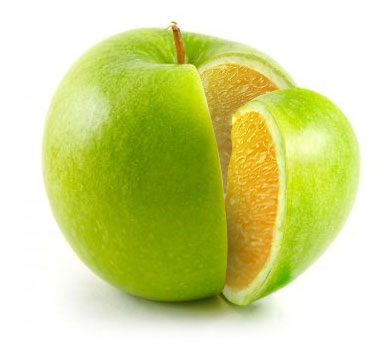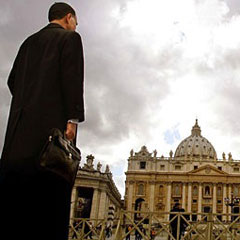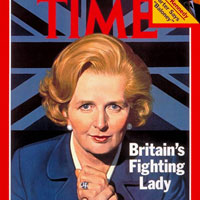In a recent gathering, Bishop Javier Echevarría, the prelate of Opus Dei, reminded his audience that the Catholic Church has only one pope, not two. He insisted that Catholics stop comparing Francis with Benedict.
“The pontificate of Benedict XVI has passed and now we have Francis. We should fight hard to get rid of any temptation to make comparisons! We should be Catholics who are on the move, who pray a lot for Pope Francis, many times each day.”
It’s good advice I think, especially in view of the relentless comparisons in the media, which create an impression that Francis is implicitly criticising his predecessor. Here’s an example from The New York Times:
[Francis] wore simple black shoes and an ordinary wristwatch with a thick black band to his first Mass as pontiff…. In an ancient institution where style often translates into substance, Francis, in his first 24 hours as pope, has dramatically shifted the tone of the papacy. Whereas Benedict XVI, the pope emeritus, was a theologian who favored red loafers, ermine-lined cloaks and erudite homilies, reviving papal fashions from centuries past, Francis, the former Cardinal Jorge Mario Bergoglio of Buenos Aires, appeared Thursday to be sending a message of radical humility.
Reading that, you might think that Pope Francis’ choice of black shoes is a deliberate rejection of Benedict’s red shoes. But I don’t remember anyone suggesting eight years ago that Pope Benedict’s choice of red shoes was a deliberate rejection of John Paul’s brown shoes.
I’m not denying that the choice of shoe colour says something about a papacy. Benedict wore red shoes because it is a centuries-old tradition, and as pope, Benedict restored or revived many traditions which were diminished or abandoned in recent decades. It spoke, I think, to an attempt to rebuild Catholic identity in a secular world. Francis wears black shoes because they’re brand new and in a spirit of poverty he will not throw them out. We can reasonably expect that spirit of poverty to impact his papacy and the Church.
But it’s drawing a much longer bow to suggest that Francis’ love of poverty is a repudiation of Benedict’s love of tradition. That’s like comparing apples and oranges, which is what journalists do, but which Catholics should resist.
Fr Julian Large, provost of the Brompton Oratory and a former journalist, wrote an excellent letter on this subject.
Soon after the election of Pope Francis, the Oratory telephone exchange was crackling with calls from the press. All of the journalists who telephoned seemed to ask the same question: “How will the new pope compare with the old one?”
How could one possibly answer? To say it was refreshing to have a pope from the new world and to suggest that we could surely expect a different style of pontificate might look, in print, like a vulgar criticism of Pope Benedict, whose deep humility, selflessness and penetrating insight will be esteemed by all decent men and women for centuries to come.
Most of us probably hope that a new pontificate will be marked by continuity with Pope Benedict’s project to re-establish a sense of Catholic identity among the faithful and to restore the mystery that makes us active participants at the most profound level in the Church’s liturgy. To say so much to the press, however, would sound presumptuous, as if we were telling the new Supreme Pontiff how to do his job.
Fr Julian suggests the media might fabricate “a virtual papacy,” in the same way it created “a virtual Council” fifty years ago. That’s not proposing a media conspiracy. It’s a comment on the wrong impressions and false expectations that excessive commentary can produce. I recommend reading his letter in full.
Journalists will naturally view Pope Francis as a Pope Benedict’s replacement. But as Catholics, we should view Pope Francis as St Peter’s successor. These understandings are quite different. For that reason alone, we should not allow the media to determine our attitude on the pope.






Yes, Pope Francis is the successor of St Peter. If he has not yet been seated on the Seat of St Peter for whatever reason, I think he should sit on the Seat of St Peter and claim that position. When we go to Heaven we will then realise that all of creation and its beauty is nothing compared to the beauty of God and Heaven. Hence, when we belong to a God of Glory and Majesty we should accept the things that belong to Him – if not for anything else but to give Him Glory and Honour. I think the Pope should wear the Gold Cross because Gold is not a metal that erodes and for that precise reason Pope Francis should wear the Gold Cross that all Popes wear. Each Pope is an individual and we should not compare Popes but we as Christians should accept each Pontiff from the Hand of God. Yes,I do agree that the Cardnals elect the Pope and that they are not infallable but God is in control and he has allowed the Cardinals to elect a Pope. All Catholics should be in prayer 24 x 7. To be in prayer is to be in the presence of God and to be in communication wth Him. To me the color of shoes does not matter, so long as the feet are protected and are comfortable to wear for long hours. All five fingers are not alike and no two popes are alike. Just as each individual is special and unique so is every pope special and unique.
I do not believe that Pope Emeritus Benedict XVI should be hidden till he dies because his prayers will be heard by Our Lord Jesus Christ and keeping him hidden will not serve any purpose. We should see him now and again just to see that he is well and okay. If we see him, it does not mean that he going to open his mouth and say anything but we the people want to see if he is well and okay because we love him and we appreciate all that he did for the Catholic Church during his Pontificate. I hope that the media will allow both the present Pope Francis and Pope Emeritus Benedict XVI to live with the Catholic people in PEACE.
Hello Florence for once I think I dont agree with you. There was only ever ONE Peter and One Peter was given the keys. At the moment we have “two Peters” and if I am correct the original Peter given the keys did not have a twin.
As long a BXVI is alive there will always be “uncertainty.”
That the new pope is lovely and appears humble and different even in the name chosen OK but I am not convinced of the theological status as it is. Will I be obedient to the teachings of Holy Church, I always try (though I fail) but still I am left uncertain…
Hi Anne! I know what you mean, but I think it’s important for us to recognise that there is only one pope. Benedict’s ministry to the Church is far from over — but then, we can say the same about St Peter and the many beatified and canonised pope who are praying for the Church in Heaven. Pope Benedict’s role, now, is more similar to Bl John Paul’s, than to Pope Francis’.
Glad I stumbled onto your blog dear country Priest. I love both the hidden beloved Benedict and now, the simply dressed Papa Francis. I am not troubled as if they are two popes. My impression is that together, they will complement one another and each, in his own unique way, according to God’s holy will will assist us on the road that leads to Christ.
Beloved Benedict, at the foot of the cross in prayer while Papa Francis tackles to the best of his ability, the world and what needs repair in the heart of the Church.
I keep hearing his plea for us to pray for him…it is important and charitable, so please, everyone, let’s pray for him as he asks.
I am grateful to almighty God that we are blessed to have them both among us and pray that much good will come of it. I cannot understand the gift fully, but I do remain grateful to our Lord for it.